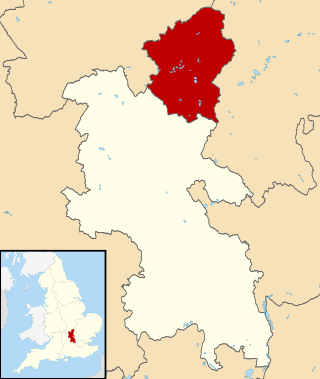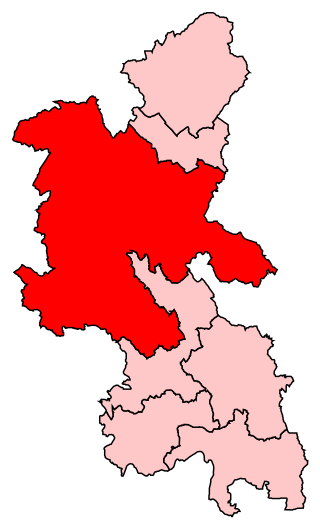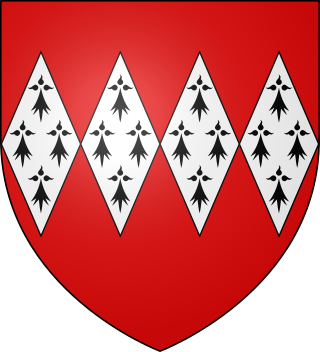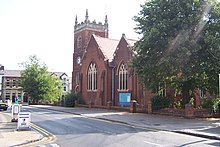
The City of Milton Keynes is a unitary authority area with both borough and city status, in Buckinghamshire. It is the northernmost district of the South East England Region. The borough abuts Bedfordshire, Northamptonshire and the remainder of Buckinghamshire.

Stony Stratford is a constituent town of Milton Keynes, Buckinghamshire, England. Historically it was a market town on the important route from London to Chester. It is also the name of a civil parish with a town council in the City of Milton Keynes. It is in the north-west corner of the Milton Keynes urban area, bordering Northamptonshire and separated from it by the River Great Ouse.

Wolverton is a constituent town of Milton Keynes, England. It is located in north-west Milton Keynes, beside the West Coast Main Line, the Grand Union Canal and the river Great Ouse. It is the administrative seat of Wolverton and Greenleys civil parish.
Sir Thomas Tresham was a British politician, soldier and administrator. He was the son of Sir William Tresham and his wife Isabel de Vaux, daughter of Sir William Vaux of Harrowden. Thomas's early advancement was due to his father's influence. In 1443 he and his father were appointed as stewards to the Duchy of Lancaster's estates in Northamptonshire, Buckinghamshire, Bedfordshire and Huntingdonshire, and by 1446 Thomas was serving as an esquire for Henry VI, being made an usher of the king's chamber in 1455. He was appointed a Justice of the Peace for Huntingdonshire in 1446, a position he held until 1459, and was returned to Parliament for Buckinghamshire in 1447 and Huntingdonshire in 1449. Despite the Tresham family's close links with the royal court they were also on good terms with Richard Plantagenet, 3rd Duke of York, and when he returned from Ireland in 1450 Tresham and his father went to greet him. Shortly after leaving home on 23 September they were attacked by a group of men involved in a property dispute with his father; William Tresham was killed, and Thomas was injured.

Buckingham is a constituency represented in the House of Commons of the UK Parliament since 2019 by Greg Smith, a Conservative.

Robert de Holland, 1st Baron Holand was an English nobleman, born in Lancashire.
James Butler, 3rd Earl of Ormond, was a noble in the Peerage of Ireland. He acceded to the title in 1382, and built Gowran Castle three years later in 1385 close to the centre of Gowran, making it his usual residence, whence his common epithet, The Earl of Gowran.

Sir John Knyvet was an English lawyer and administrator. He was Chief Justice of the King's Bench from 1365 to 1372, and Lord Chancellor of England from 1372 to 1377.

This history of Milton Keynes details its development from the earliest human settlements, through the plans for a 'new city' for 250,000 people in northern Southeast England, its subsequent urban design and development, to the present day. Milton Keynes is the largest settlement and only city in Buckinghamshire, founded in 1967. At the 2021 census, the population of its urban area was estimated to have exceeded 256,000.
Sir Thomas Billing was an English judge and Chief Justice of the King's Bench.

Thomas de Morley, 4th Baron Morley, KG was a baron in the Peerage of England, Lord of Morley, Hingham, Hockering, &c., in Norfolk, de jure Lord Marshall, hereditary Earl Marshal of Ireland, and a Privy Councillor. He was summoned to parliament from 20 October 1379 to 3 September 1416.

Longueville-sur-Scie is a commune in the Seine-Maritime department in the Normandy region in northern France.

Margaret de Bohun, Countess of Devon was the granddaughter of King Edward I and Eleanor of Castile, and the wife of Hugh Courtenay, 10th Earl of Devon (1303–1377). Her seventeen children included an Archbishop of Canterbury and six knights, of whom two were founder knights of the Order of the Garter. Unlike most women of her day, she received a classical education and was a lifelong scholar and collector of books.
John Lawton (1656–1736) was an English Member of Parliament
This is a list of Sheriffs of Bedfordshire and Buckinghamshire. One sheriff was appointed for both counties from 1125 until the end of 1575, after which separate sheriffs were appointed. See High Sheriff of Bedfordshire and High Sheriff of Buckinghamshire for dates before 1125 or after 1575.

Sir William de Notton, or Norton was an English landowner and judge, who had a highly successful career in both England and Ireland, culminating in his appointment as Lord Chief Justice of Ireland in 1361.
Sir Ralph Hastings, third son of Sir Leonard Hastings, was a supporter of the House of York during the Wars of the Roses. He fought at the Battle of Barnet, and was knighted at the Battle of Tewkesbury. He held numerous offices during the reign of Edward IV, including Keeper of the Lions and Leopards in the Tower of London, and Lieutenant of Guisnes and Captain of Calais.

Sir Richard Arches, of Eythrope, in the parish of Waddesdon, Buckinghamshire, was MP for Buckinghamshire in 1402. He was knighted before 1401.

Sir John Dinham (1406–1458) was a knight from Devonshire, England. His principal seats were at Nutwell and Kingskerswell in South Devon and Hartland in North Devon.
Sir Peter Mallore, or Mallory was a prominent landowner and local politician in fourteenth-century Northamptonshire, who also served as a judge in Ireland. His career was marked by controversy: he was imprisoned on at least two occasions, the second time for assaulting another judge. The troubles of his later years were due largely to the actions of his son Giles, who was accused of wasting the inheritance of his infant stepson and ward. Fortunately for his career, Sir Peter enjoyed the personal regard of a number of influential men, notably the Black Prince and King David II of Scotland.












